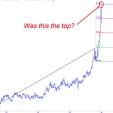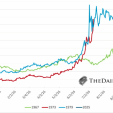Silver Price Doldrums
For a long time while I watched the Shanghai prices, the changes were rather on the slow side and quite limited, mostly changing slowly to complete a trend. More recently, this pattern has changed, in a way that is more noticeable for silver prices. The changes have become larger and more rapid and oscillating, rather than holding to a trend for a length of time. Makes one wonder, because SGE is a physical market, whether the large withdrawals from EFTs some weeks ago has something to do with this change in behaviour – that the withdrawals were intended to influence prices in Shanghai in a similar way to what is done on the paper-driven Comex.
The difference between the price of gold on SGE and on Comex gradually narrowed over the past week or two, from a few dollars down to the $0.16 at time of writing on Sunday morning (SAT). In contrast, the gap for the price of silver has narrowed from about $1,20 not too long ago, but it is still $0.80 at time of writing, mostly as a result of the Comex price slowly following the SGE price higher – finally breaking above the 417 level while the SGE has been quite comfortable holding above $18. While the price of gold on SGE has been quite steady, in a narrow range around the $255 level, increasing slowly to R266, the SGE price of silver has been very volatile – frequently testing support at $18, then rebounding higher as if resisting whatever pressure had forced it lower to test the psychological support.
At the same time, the behaviour of Wall Street shows a repeating pattern through the whole day. The SP500 futures almost invariably begins the trading day in Asia in the red, mostly trending slowly lower as negative sentiment is rising. By the time London opens, the trend has changed to steady to bullish, with the futures moving a little into positive territory as the time of the NYSE open approaches. Then, when the New York markets opens, more often than not the market ramps higher, much more than the pre-market futures had indicated; almost as if someone had goosed the market into a strong bullish reaction.
After the open spike higher, the market would become more sideways volatile, with frequent dips as selling takes control, only to reverse higher again to remain range bound. On those occasions when the market opened sharply weaker, the plunge is soon reversed as steeply either to turn just bullish again or trend gradually higher and close little changed on the day.
Each day the message from the behaviour of the stock market is someone powerful feels very strongly there should be no indication that A bear might be lurking in the wings. The most important barometer of US economic health has to placate people on Main Street that all is well – ably assisted in this by the mass media.
It is only the weakness in the dollar that offers some evidence that all might not be as well as it appears from other indicators – the gold price is near recent lows, the DJIA is above 21 000, the yield on the 10-year is steady to even a little bullish. The image of a hand every so often screwing the safety valve on a hot pressure cooker a little more tightly to prevent the steam from escaping comes to mind. Having on one occasion a long time ago seen the results when a real pressure cooker blows in a kitchen, there is a certain curiosity about what such an event in financial markets look like. Provided, of course, one can observe the event from afar, both financially and geographically speaking.
Euro-Dollar
Euro-dollar, last = $1.1183 (www.investing.com)
The resistance at line X ($1.0871) for about two weeks kept the euro at bay, but it is no longer of any influence, although markets have been acting in surprising ways for some time now. Once released from the steep bear channel, the euro popped to a new recent high on Friday. The next resistance is at line R ($1.1303) and while it still seemed well out of reach two weeks ago, the recent move higher has brought the euro so close to line R that it could be tested very soon – perhaps even as early this week, should the dollar bear tighten its hold on the currency.
DJIA
The steep decline two weeks ago as a consequence of White House rumours, at first had the DJIA testing resistance at line S (20 985) and last week with a minor break higher also above 21 000. The DJIA remains vulnerable while this break holds just marginally above line S, as it is doing. However, the decisive moment will be when support at the bottom of bull channel KL (20 410) is tested.
DJIA, last = 21080.28 (money.cnn.com)
Gold PM Fix - Dollars
Gold price – London PM fix, last = $1263.05 (www.kitco.com )
As written last week, the London PM fix is clinging closely to steep support along line L ($1246) – increasing by about $6/week – following its reversal off support at line L not so long ago. Line G ($1279) – declining at about $5/week – has held firm as resistance since mid 2011, with only one brief and marginal break higher. It can be expected to again offer firm resistance when tested, perhaps in the near future, if gold can begin to break free of its shackles.
While there is more resistance not far ahead after line G, a break higher above a 6- year resistance line – the top of pennant GZ – should be bullish for the medium to longer term. Note that this break would take place while gold is still on leg 4 of this pennant, without having completed leg 4 to begin leg 5. Similar ‘premature’ breaks in the past have tended to be steep and sustained.
Euro-Gold PM Fix
Euro gold price – PM fix in Euro, last = €1132.9 (www.kitco.com)
While the euro and the price of gold moved in different directions two weeks ago, at least from the perspective of the euro price of gold, the euro price held mostly sideways in a tight range. A steady to stronger gold price last week performed better against the US dollar than the euro had managed to do and this had a positive effect on the euro price of gold. The price has opened up the gap to the key support at line S (€1110), but has quite a way to go before it will reach the resistance at the bottom of bull channel YZ (€1156).
Until then, the break before broad bull channel VZ has to be taken as bearish for the euro price of gold, with expectations for a sideways drift, at least while support at line S holds.
Silver Daily London Fix
Silver’s break above the steep pennant ZF also happened on leg 4 – after it failed to reach the support at line Z after rebounding lower from resistance at line F. In this instance, the new move higher was not steep and sustained, as usually associated with such quite rare premature breaks. The initial rally off line W ($19.17) ran into resistance at lines X ($18.26) and G ($15.17), then followed line G lower to remain in bear channel FG – to break below line W – until support at line D ($16.25) held firm, to trigger a reversal higher.
This time, line W acted as resistance and the price had to drift sideways within the small triangle formed by lines X and D. The price is now on leg 4 of this triangle to raise expectations that the rising trend will break above line X to resume the bullish trend. That would be good news if it happened, but even better would be should the silver price break back into the long term channel VW.
Silver daily London fix, last = $17.29 (www.kitco.com)
US 10-year Treasury Note
When the market of the US 10-year Treasury note rallied steeply to end just short of line D (2.226%) ten days ago, it was as if promising to extend lower. However, last week the trend reversed to hold mostly below line X (2.276%), but still in bear channel CD. It seems we have to wait to see if this channel can hold, perhaps as a sign that belief in a sound financial system capable of dealing with high levels of national and other debt is still widespread enough to prevent heavy liquidation of Treasuries, in particular by foreigners who have to be increasingly worried by the weaker dollar.
U.S. 10-year Treasury note, last = 2.250% (www.investing.com )
West Texas Intermediate Crude. Daily Close
WTI Crude – Daily Close, last = $49.80 (www.investing.com )
It was in late 2014 when the price of crude last managed to hold above channel XY (X: $51.84, Y: $43.24) for any length of time. Since then. all the break above line X were limited and brief. Lie Y was more successful acting as support.
The last break higher reversed off resistance at line R ($54.75) also broke back below line X, but held short of line Y and line C ($45.67). The fresh rally off line C reversed lower off line X, to show the market is suspicious that shale production will more than balance any cuts in production by OPEC, to sustain the imbalance that has existed for a long time in the supply-demand relationship.
The fact that a price for crude above the $50 dollar level – represented by line X – is where shale producers apparently see an opportunity for a positive cash flow to reduce their difficult financial position, implies a reason for the two year ceiling in the price for crude. On the other hand, a price approaching the support at line Y prompts shale producers to reduce the number of active wells; production declines and this has a positive effect on the price of crude.
********


















